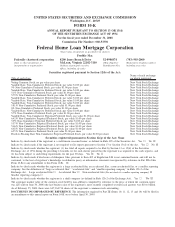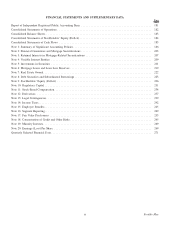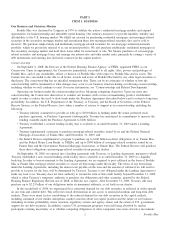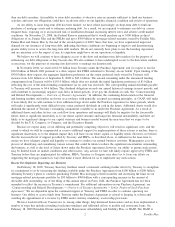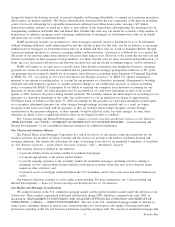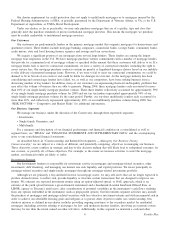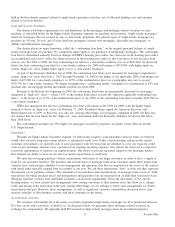Freddie Mac 2008 Annual Report Download - page 11
Download and view the complete annual report
Please find page 11 of the 2008 Freddie Mac annual report below. You can navigate through the pages in the report by either clicking on the pages listed below, or by using the keyword search tool below to find specific information within the annual report.held in the Investments segment related to single-family guarantee activities, net of allocated funding costs and amounts
related to net float benefits.
Loan and Security Purchases
Our charter establishes requirements for and limitations on the mortgages and mortgage-related securities we may
purchase, as described below. In the Single-family Guarantee segment, we purchase and securitize “single-family mortgages,”
which are mortgages that are secured by one- to four-family properties. The primary types of single-family mortgages we
purchase are 30-year, 20-year, and 15-year fixed-rate mortgages, interest-only mortgages, adjustable rate mortgages, or
ARMs, and balloon/reset mortgages.
Our charter places an upper limitation, called the “conforming loan limit,” on the original principal balance of single-
family mortgage loans we purchase. No comparable limits apply to our purchases of multifamily mortgages. The conforming
loan limit is determined annually based on changes in FHFA’s housing price index. Any decreases in the housing price index
are accumulated and used to offset any future increases in the housing price index so that loan limits do not decrease from
year-to-year. For 2006 to 2008, the base conforming loan limit for a one-family residence was set at $417,000. As discussed
below, the base conforming loan limit for a one-family residence for 2009 will remain at $417,000, with higher limits in
certain “high-cost” areas. Higher limits apply to two- to four-family residences.
As part of the Economic Stimulus Act of 2008, the conforming loan limits were increased for mortgages originated in
certain “high-cost” areas from July 1, 2007 through December 31, 2008 to the higher of the applicable 2008 conforming loan
limits, ($417,000 for a one-family residence), or 125% of the median house price for a geographic area, not to exceed
$729,750 for a one-family residence. We began accepting these “conforming jumbo” mortgages for securitization as PCs and
purchase into our mortgage-related investments portfolio in April 2008.
Pursuant to the Reform Act beginning in 2009, the conforming loan limits are permanently increased for mortgages
originated in “high-cost” areas — where 115% of the median house price exceeds the otherwise applicable conforming loan
limit — to the lesser of (i) 115% of the median house price or (ii) 150% of the conforming loan limit (currently $625,500 for
a one-family residence).
FHFA has announced that the base conforming loan limit will remain at $417,000 for 2009, with the higher limits,
referred to above, in “high-cost” areas. On February 17, 2009, President Obama signed the American Recovery and
Reinvestment Act of 2009, or Recovery Act, into law. Among other things, for mortgages originated in 2009, the Recovery
Act ensures that the loan limits for the “high-cost” areas determined under the Economic Stimulus Act do not fall below
their 2008 levels.
The conforming loan limits are 50% higher for mortgages secured by properties in Alaska, Guam, Hawaii and the
U.S. Virgin Islands.
Guarantees
Through our Single-family Guarantee segment, we historically sought to issue guarantees with fee terms we believed
would offer attractive long-term returns relative to anticipated credit costs. Under conservatorship, and given the current
economic environment, we currently seek to issue guarantees with fee terms that are intended to cover our expected credit
costs on new purchases and that cover a portion of our ongoing operating expenses. Our current fee terms are not expected
to provide opportunities to increase our capital position. Our efforts to provide increased support to the mortgage market
have limited our ability to increase our fees for current expectations of credit risk.
We enter into mortgage purchase volume commitments with many of our larger customers in order to have a supply of
loans for our guarantee business. The purchase and securitization of mortgage loans from customers under these longer-term
contracts have fixed pricing schedules for our management and guarantee fees that are negotiated at the outset of the contract
with initial terms typically ranging from six months to one year. We call these transactions “flow” activity and they represent
the majority of our purchase volumes. The remainder of our purchases and securitizations of mortgage loans occurs in “bulk”
transactions for which purchase prices and management and guarantee fees are negotiated on an individual transaction basis.
Mortgage purchase volumes from individual customers can fluctuate significantly. Given the uncertainty of the current
housing market, we have entered into arrangements with existing customers at their renewal dates that allow us to change
credit and pricing terms faster than in the past; among other things, we are seeking to renew such arrangements for shorter
terms than in the past. However, these arrangements, as well as significant customer consolidation discussed above, may
increase volatility of flow-business activity with these customers in the future.
Securitization Activities
We securitize substantially all of the newly or recently originated single-family mortgages we have purchased and issue
PCs that can be sold to investors or held by us. As discussed below, we guarantee these mortgage-related securities in
exchange for compensation. We generally hold PCs instead of single-family mortgage loans for investment purposes,
8Freddie Mac

